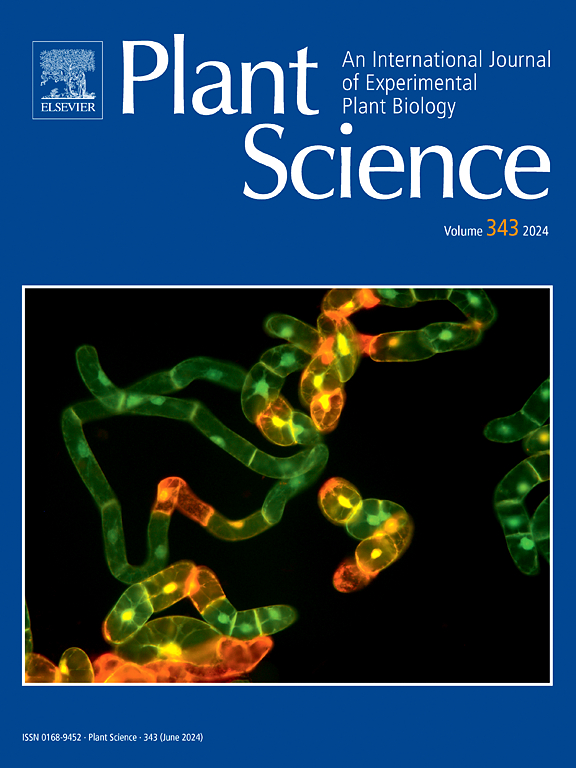Reduced callose modulates stem mechanical strength in Paeonia lactiflora: Insights from xylem fiber cell formation, carbon transport and material metabolism
IF 4.2
2区 生物学
Q2 BIOCHEMISTRY & MOLECULAR BIOLOGY
引用次数: 0
Abstract
Paeonia lactiflora is an important garden ornamental flower and has become a new cut flower in the international market in recent years. Stem mechanical strength is an important index of cut flower quality. P. lactiflora cultivars possess varying stem mechanical strength, which directly result in different cut P. lactiflora quality. In our previous study, a significant difference in phloem callose deposition was detected between two P. lactiflora cultivars with varying stem mechanical strength. However, the relationship and interaction mechanism between the phloem callose and mechanical strength in P. lactiflora stems are still unclear. This study aimed to analyze the effects of reduced phloem callose on the mechanical strength in P. lactiflora stems. The results revealed a negative correlation between the callose content and mechanical strength in P. lactiflora stems during early developmental stages. Exogenous 2DDG treatment led to a 13.6 % reduction in the callose content, concomitantly enhancing the stem mechanical strength by 14.2 % via facilitating the formation and secondary cell wall (SCW) thickening of xylem fiber cells. Further investigations showed that exogenous 2DDG treatment promoted carbon transport in P. lactiflora stems, thereby increasing the carbon content. Additionally, it induced alterations in the metabolism of lipids, amino acids, and organic acids in the stems and spurred the diffusion of lipids from the pith to the xylem. Consequently, reducing the content of callose improved the formation and SCW thickening of xylem fiber cells by modifying material transport and metabolism, thereby enhancing the stem mechanical strength of P. lactiflora. This study offers novel perspectives regarding the regulatory mechanism of P. lactiflora stem mechanical strength.
减少胼胝质调节芍药茎的机械强度:从木质部纤维细胞形成,碳运输和物质代谢的见解。
芍药是一种重要的园林观赏花卉,近年来在国际市场上成为一种新型切花。茎部机械强度是衡量切花品质的重要指标。乳香品种茎秆机械强度的差异,直接导致了乳香切块品质的差异。在我们之前的研究中,发现不同茎秆机械强度的两个乳香品种韧皮部胼胝质沉积有显著差异。然而,乳酸菌韧皮部胼胝质与机械强度之间的关系及其相互作用机制尚不清楚。本研究旨在分析韧皮部胼胝质减少对乳香茎机械强度的影响。结果表明,乳香草茎发育早期胼胝质含量与机械强度呈负相关。外源2DDG处理导致其胼胝质含量降低13.6%,同时通过促进木质部纤维细胞的形成和次生细胞壁(SCW)增厚,使茎的机械强度提高14.2%。进一步研究表明,外源2DDG处理促进了乳酸菌茎部的碳转运,从而提高了其碳含量。此外,它诱导了茎中脂质、氨基酸和有机酸代谢的改变,并刺激了脂质从髓向木质部的扩散。因此,降低胼胝质含量通过改变物质的运输和代谢,促进了木质部纤维细胞的形成和SCW增厚,从而提高了乳香茎的机械强度。本研究为乳酸菌茎秆机械强度的调控机制提供了新的视角。
本文章由计算机程序翻译,如有差异,请以英文原文为准。
求助全文
约1分钟内获得全文
求助全文
来源期刊

Plant Science
生物-生化与分子生物学
CiteScore
9.10
自引率
1.90%
发文量
322
审稿时长
33 days
期刊介绍:
Plant Science will publish in the minimum of time, research manuscripts as well as commissioned reviews and commentaries recommended by its referees in all areas of experimental plant biology with emphasis in the broad areas of genomics, proteomics, biochemistry (including enzymology), physiology, cell biology, development, genetics, functional plant breeding, systems biology and the interaction of plants with the environment.
Manuscripts for full consideration should be written concisely and essentially as a final report. The main criterion for publication is that the manuscript must contain original and significant insights that lead to a better understanding of fundamental plant biology. Papers centering on plant cell culture should be of interest to a wide audience and methods employed result in a substantial improvement over existing established techniques and approaches. Methods papers are welcome only when the technique(s) described is novel or provides a major advancement of established protocols.
 求助内容:
求助内容: 应助结果提醒方式:
应助结果提醒方式:


